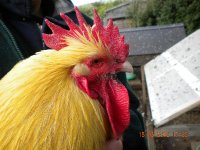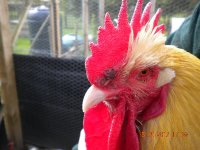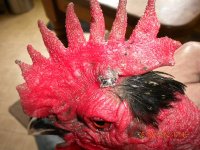chrismahon
Well-known member
Having read that Fowl Pox is in the UK and there are outbreaks in the Midlands I was a bit worried about our Basil. I thought these scabby areas were the result of squabbling with Frankie through the wire mesh. But they are very slow to mend and after two weeks we've started applying Teatree cream daily with minor improvement. What do you all think?


Also noticed a funny growth on the side of Claude's comb. It''s very hard and I wondered if it was an ingrowing feather or some other kind of growth?

He's eating fine and full of beans. No sign of his Canker returning. His tongue is still dead at the end but as he is absolutely fine with it there will be no operation for removal.


Also noticed a funny growth on the side of Claude's comb. It''s very hard and I wondered if it was an ingrowing feather or some other kind of growth?

He's eating fine and full of beans. No sign of his Canker returning. His tongue is still dead at the end but as he is absolutely fine with it there will be no operation for removal.
